While the living primates are a varied group of animals, they do share a number of features. We humans, for example, can grasp, throw, and see in three dimensions because of shared primate characteristics. Compared to other mammals, primates possess a relatively unspecialized anatomy while their behavioral patterns are diverse and flexible.
Many primate characteristics are useful to arboreal animals, although (as any squirrel knows) they are not essential to life in the trees. For animals preying upon the many insects living on the fruit and flowers of trees and shrubs, however, primate characteristics such as dexterous hands and keen vision would have been enormously adaptive. Life in the trees, along with the visual predation of insects, played a role in the evolution of primate biology.
The varied diet available to arboreal primates—shoots, leaves, insects, and fruits—did not require the specialization of teeth seen in other mammals. In most primates
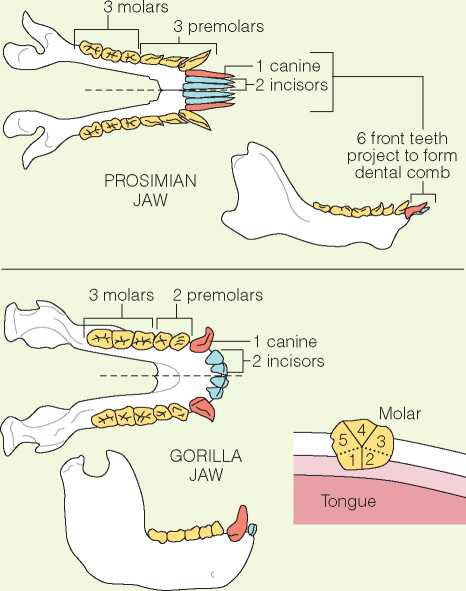
Figure 3.4 Because the exact number and shape of the teeth differ among primate groups, teeth are frequently used to identify evolutionary relationships and group membership. Prosimians (top), with a dental formula of 2-1-3-3, possess two incisors, one canine, three premolars, and three molars on each side of their upper and lower jaws. Also, lower canines and incisors project forward, forming a “dental comb," which is used for grooming. A dental formula of 2-1-2-3, typical of Old World monkeys and apes, can be seen in the gorilla jaw (bottom). Note the large projecting canines. On one of the molars, the cusps are numbered to illustrate the Y5 pattern found in hominoids.
(humans included), on each side of each jaw, in front, are two straight-edged, chisel-like broad teeth called incisors (Figure 3.4). Behind each incisor is a canine tooth, which in many mammals is large, flaring, and fanglike. The canines are used for defense as well as for tearing and shredding food.
In humans, canine tooth size is relatively small, although it has an oversized root, suggestive of larger canines some time back in our ancestry. Behind the canines are the premolars and molars (the “cheek teeth”) for grinding and chewing food. Molars erupt through the gums while a young primate is maturing (6-year molars, 12-year molars, and wisdom teeth in humans). Thus the functions of grasping, cutting, and grinding were served by different kinds of teeth. The exact number of premolars and molars and the shape of individual teeth differ among primate groups (Table 3.2).
The evolutionary trend for primate dentition has been toward a reduction in the number and size of the teeth. The ancestral dental formula, or pattern of tooth type and number in mammals, consisted of three incisors, one canine, five premolars, and three molars (expressed as 3-1-5-3) on each side of the jaw, top and bottom, for a total of forty-eight teeth. In the early stages of primate evolution, one incisor and one premolar were lost on each side of each jaw, resulting in a dental pattern of 2-1-4-3 in the early fossil primates. This change differentiated primates from other mammals.
Over the millennia, as the first and second premolars became smaller and eventually disappeared altogether, the third and fourth premolars grew larger and added a second pointed projection, or cusp, thus becoming “bicuspid.” In humans, all eight premolars are bicuspid, but in other Old World anthropoids, the lower first premolar is not bicuspid. Instead, it is a specialized, single-cusped tooth with a sharp edge to act with the upper canine as a shearing mechanism. The molars, meanwhile, evolved from a three-cusp pattern to one with four and even five cusps. The five-cusp pattern is characteristic of the lower molars of living and extinct hominoids (see Figure 3.4). Because the grooves separating the five cusps of a hominoid lower molar looks like the letter Y, hominoid lower molars are said to have a Y5 pattern. In humans there has been some departure from the Y5 pattern associated with the reduction in tooth and jaw size such that the second and third molars generally have only four cusps. Four - and five-cusp molars economically combined the functions of grasping, cutting, and grinding in one tooth.
The evolutionary trend for human dentition has generally been toward economy, with fewer, smaller, more efficient teeth doing more work. Thus our own thirty-two teeth (a 2-1-2-3 dental formula shared with the Old World monkeys and apes) are fewer than the teeth of some primates and more generalized than those of most primates. However, this trend does not indicate that species with more teeth are less evolved; it only shows that their evolutionary history followed different trends.
The canines of most primates develop into long, daggerlike teeth that enable them to rip open tough husks of fruit and other foods. In many species, males possess larger canine teeth compared to females. This sex difference is an example of sexual dimorphism—differences between the sexes in the shape or size of a feature. These large canines are used frequently for social communication. All an adult male gorilla, baboon, or mandrill needs to do to get a youngster to be submissive is to raise his upper lip to display his large, sharp canines.
The primates’ adaptation to arboreal life involved changes in the form and function of their sensory organs. The sense of smell was vital for the earliest ground-dwelling, night-active
Dental formula The number of each tooth type (incisors, canines, premolars, and molars) on one half of each jaw. Unlike other mammals, primates possess equal numbers on their upper and lower jaws so the dental formula for the species is a single series of numbers.
Sexual dimorphism Within a single species, differences between males and females in the shape or size of a feature not directly related to reproduction, such as body size or canine tooth shape and size.
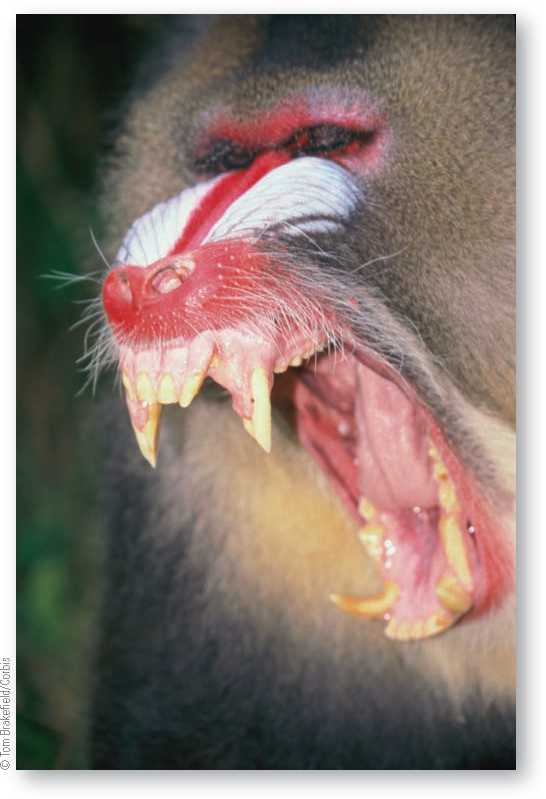
Though the massive canine teeth of some male primates are serious weapons, they are more often used to communicate rather than to draw blood. Raising his lip to flash his canines, this mandrill will get the young members of his group in line right away. Over the course of human evolution, overall canine size decreased, as did differences in canine size between males and females.
Objects hanging in space, such as vines or branches. Monkeys, apes, and humans achieved this through binocular stereoscopic color vision (Figure 3.5), the ability to see the world in the three dimensions of height, width, and depth. Binocular vision (in which two eyes sit next to each other on the same plane so that their visual fields overlap) and nerve connections that run from each eye to both sides of the brain confer complete depth perception characteristic of three-dimensional or stereoscopic vision. This arrangement allows nerve cells to integrate the images derived from each eye. Increased brain size in the visual area in primates, and a greater complexity at nerve connections, also contribute to stereoscopic color vision.
Visual acuity, however, varies throughout the primate order in terms of both color and spatial perception. Prosimians, most of whom are nocturnal, lack color vision. The eyes of lemurs and lorises (but not tarsiers) are capable of reflecting light off the retina, the surface where nerve fibers gather images in the back of the eye to intensify the limited light available in the forest at night. In addition, prosimian vision is binocular without the benefits of stereoscopy. Their eyes look out from either side of their muzzle or snout. Though there is some overlap of visual fields, their nerve fibers do not cross from each eye to both halves of the brain.
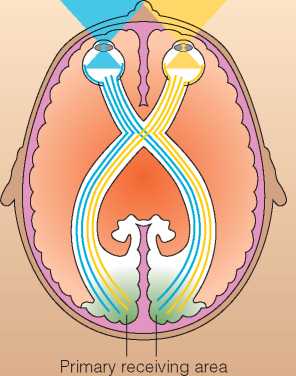
For visual information
Figure 3.5 Monkeys, apes, and humans possess binocular stereoscopic vision. Binocular vision refers to overlapping visual fields due to forward-facing eyes. Three-dimensional or stereoscopic vision comes from binocular vision and the transmission of information from each eye to both sides of the brain.
Mammals. It enabled them to operate in the dark, to sniff out their food, and to detect hidden predators. However, for active tree life during daylight, good vision is a better guide than smell in judging the location of the next branch or tasty morsel. Accordingly, the sense of smell declined in primates, while vision became highly developed.
Travel through the trees demands judgments concerning depth, direction, distance, and the relationships of
Binocular vision Vision with increased depth perception from two eyes set next to each other, allowing their visual fields to overlap.
Stereoscopic vision Complete three-dimensional vision (or depth perception) from binocular vision and nerve connections that run from each eye to both sides of the brain, allowing nerve cells to integrate the images derived from each eye.
Biocultural Connection
Why Red Is Such a Potent Color by Meredith F. Small
The Olympic athletes have been parading around like fashionistas in an array of colorful outfits, and we, their adoring public, can't resist commenting on the style and color of their high-end athletic wear. My favorite was the faux silk, faux embroidered, slinky red leotards of the Chinese women's gymnasts.
Apparently, as researchers have recently discovered, the choice of red for those leotards might also have given the Chinese gymnasts an advantage. But why is the color red so impressive?
The answer lies in our tree-living past.

The human response to the color red may well be rooted in our anthropoid heritage. Could this have given the Chinese gymnastic team an edge? It is certain that our ape ancestry contributes to the human range of motion. While we are all not able to move in the same ways that these talented gymnasts can, the human ability to grasp, swing, stretch, and throw things derives from characteristics of the hands and shoulders inherited from our ape ancestors.
In the back of the vertebrate eyeball are two kinds of cells called rods and cones that respond to light. Cones take in a wide range of light, which means they recognize colors, and they are stimulated best during daylight. Rods respond to a narrower range of light (meaning only white light) but notice that light from far away and at night.
Isaac Newton was the first person to hold up a prism and refract white light into a rainbow of colors and realize that there might be variation in what the eye can see. Color comes at us in electromagnetic waves. When the wavelength of light is short we perceive purple or blue. Medium wavelengths of lights tickle the cones in another way and we think green. Short light wavelengths make those cones stand up and dance as bright spots of yellow, orange, and red.
Various animals distinguish only parts of that rainbow because their cones respond in different ways. Butterflies, for example, see into the ultraviolet end of the rainbow, which allows them to see their own complex markings better than we can. Foxes and owls are basically color-blind and it doesn't matter because they are awake at night when the light spectrum is limited anyway.
Humans are lucky enough to be primates, animals with decent color vision, and we can thank monkeys for this special ability.
Long ago, primitive primates that resemble today's lemurs and lorises saw only green and blue, the longer wavelengths of color. But when monkeys evolved, around 34 million years ago, their cones became sensitive to even shorter wavelengths of color and they saw red.
And what a difference. With red, the forest comes alive. Instead of a blanket of bluish-green leaves, the world is suddenly accented with ripe red, yellow, and
Orange fruits, and even the leaves look different.
For a monkey leaping through the forest canopy, color vision would be an essential advantage. Unripe fruit doesn't have enough carbs to sustain a hungry primate and they taste really sour. Unripe leaves not only taste bad, they are toxic and indigestible.
For the first humans foraging about the forest and savannah around 5 million years ago, it would have been be much more efficient to spot a ripe fruit or tuber than bite into a zillion just to get the right one. And so humans ended up with color vision even though we no longer live in trees.
But color is more than wavelengths, more than an indicator of ripeness, to us.
Color has become symbolic, meaning it has meaning, and that meaning is highly cultural.
Chinese athletes and Chinese brides wear red because red is considered lucky. The U. S. athletes also wear red because that bright color is in the U. S. flag, and because designers of athletic wear, as well as scientists, know that red gets you noticed.
BIOCULTURAL QUESTION
While the vast majority of humans see color as described here, 8 to 20 percent of human males have red-green color blindness. Do you know someone who is color-blind? What could a conversation with a color-blind person reveal about the anthropological perspective? What colors besides red have particular meanings? Do these meanings derive from biology or culture?
Adapted from Small, M. F. (2008, August 15). Why red is such a potent color. Live Science. Http://www. Livescience. com/culture/080815-Hn-color-red. html.
By contrast, monkeys, apes, and humans possess both color and stereoscopic vision. Color vision markedly improves the diet of these primates compared to most other mammals. The ability to distinguish colors allows anthropoid primates to choose ripe fruits or tender immature leaves due to their red rather than green coloration. See this chapter’s Biocultural Connection to see how our primate ancestry affects our response to color.
In addition to color vision, anthropoid primates possess a unique structure called the fovea centralis, or central pit, in the retina of each eye. Like a camera lens, this feature enables the animal to focus on a particular object
Fovea centralis A shallow pit in the retina of the eye that enables an animal to focus on an object while maintaining visual contact with its surroundings.
For acutely clear perception without sacrificing visual contact with the object’s surroundings.
The primates’ emphasis on visual acuity came at the expense of their sense of smell. Smells are processed in the forebrain, a part of the brain that projects into the snout of animals depending upon smells. A large protruding snout, however, may interfere with stereoscopic vision. But smell is an expendable sense to diurnal tree-dwelling animals in search of insects; they no longer needed to live a “nose to the ground” existence, sniffing the ground in search of food. The anthropoids especially have the least-developed sense of smell of all land animals. Though our sense of smell allows humans to distinguish perfumes, and even to distinguish family members from strangers, our brains have come to emphasize vision rather than smell. Prosimians, by contrast, still rely more on smell than on vision, possessing numerous scent glands for marking objects in their territories.
Arboreal primates also possess an acute sense of touch. An effective feeling and grasping mechanism helps prevent them from falling and tumbling while speeding through the trees. The early mammals from which primates evolved possessed tiny touch-sensitive hairs at the tips of their hands and feet. In primates, sensitive pads backed up by nails on the tips of the animals’ fingers and toes replaced these hairs.
These changes in sensory organs have corresponding changes to the primate brain. In addition, an increase in brain size, particularly in the cerebral hemispheres—the areas supporting conscious thought—occurred in the course of primate evolution. In monkeys, apes, and humans, the cerebral hemispheres completely cover the cerebellum, the part of the brain that coordinates the muscles and maintains body balance.
One of the most significant outcomes of this development is the flexibility seen in primate behavior. Rather than relying on reflexes controlled by the cerebellum, primates constantly react to a variety of features in the environment. Messages from the hands and feet, eyes and ears, as well as from the sensors of balance, movement, heat, touch, and pain, are simultaneously relayed to the cerebral cortex. Obviously the cortex had to evolve considerably in order to receive, analyze, and coordinate these impressions
Ecological niche A species’ way of life considered in the full context of its environment, including factors such as diet, activity, terrain, vegetation, predators, prey, and climate. vertebrate An animal with a backbone, including fish, amphibians, reptiles, birds, and mammals. cranium The braincase of the skull.
And transmit the appropriate response back down to the motor nerves. The enlarged, responsive cerebral cortex provides the biological basis for flexible behavior patterns found in all primates, including humans.
There are many reasons for the increased learning capacity of the primate brain, but it likely started as the earliest primates, along with many other mammals, began to carry out their activities in the daylight hours. Prior to 65 million years ago, mammals seem to have been nocturnal in their habits. The extinction of the dinosaurs
And climate change at that time opened new ecological
Niches—a species’ way of life considered in the full context of its environment, including other species, geology, climate, and so on. With the change to a diurnal life, the sense of vision took on greater importance, and so visual acuity was favored by natural selection. Unlike reptile vision, where the information-processing neurons are in the retina, mammalian vision is processed in the brain, permitting integration with information received through other senses such as sound, touch, taste, and smell.
If the evolution of visual acuity led to larger brains, it is likely that the primates’ insect predation in an arboreal setting also played a role in enlargement of the brain. This would have required great agility and muscular coordination, favoring development of the brain centers. Thus it is of interest that much of the higher mental faculties are apparently developed in an area alongside the motor centers of the brain.30
Another related hypothesis that may help account for primate brain enlargement involves the use of hands as tactile instruments to replace the teeth and jaws or snout. The hands assumed some of the grasping, tearing, and dividing functions of the jaws, again requiring development of the brain centers for more complete coordination.
The skeleton gives animals with internal backbones, or vertebrates, their basic shape or silhouette, supports the soft tissues, and helps protect vital internal organs (Figure 3.6). In primates, for example, the skull protects the brain and the eyes. A number of factors are responsible for the shape of the primate skull as compared with those of most other mammals: changes in dentition, changes in the sensory organs of sight and smell, and increased brain size.
The primate braincase, or cranium, tends to be high and vaulted. A solid partition exists in anthropoid primates between the eye and the temple, affording maximum protection to the eyes from the contraction of the chewing muscles positioned directly next to the eyes.
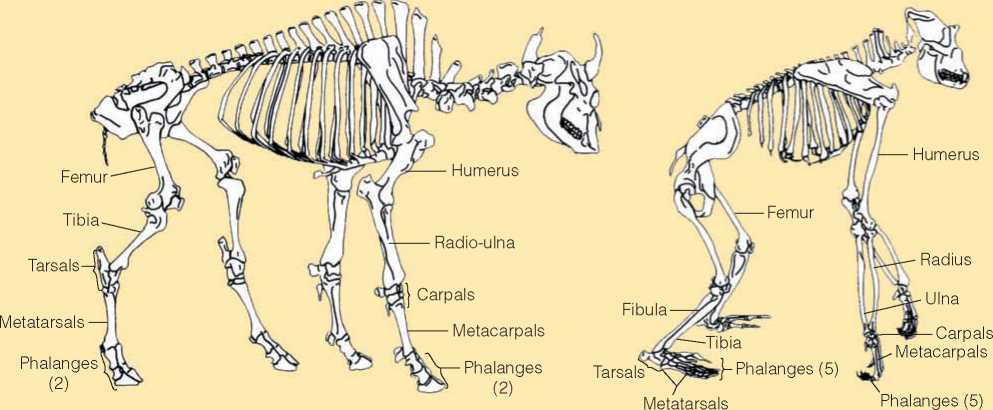
Figure 3.6 All primates possess the same ancestral vertebrate limb pattern seen in reptiles and amphibians, consisting of a single upper long bone, two lower long bones, and five radiating digits (fingers and toes), as seen in this gorilla (right) skeleton. Other mammals such as bison (left) have a modified version of this pattern. In the course of evolution, bison have lost all but two of their digits, which form their hooves. The second long bone in the lower part of the limb is reduced. Note also the joining of the skull and vertebral column in these skeletons. In bison (as in most mammals) the skull projects forward from the vertebral column, but in semi-erect gorillas, the vertebral column is further beneath the skull.
The foramen magnum (the large opening at the base of the skull through which the spinal cord passes and connects to the brain) is an important clue to evolutionary relationships. In most mammals, as in dogs and horses, this opening faces directly backward, with the skull projecting forward from the vertebral column. In humans, by contrast, the vertebral column joins the skull toward the center of its base, thereby placing the skull in a balanced position as required for habitual upright posture. Other primates, though they frequently cling, sit, or hang with their bodies upright, are not as fully committed to upright posture as humans, and so their foramen magnum is not as far forward.
In anthropoid primates, the snout or muzzle portion of the skull reduced as the acuity of the sense of smell declined. The smaller snout offers less interference with stereoscopic vision; it also enables the eyes to take a frontal position. As a result, primates have flatter faces than some other mammals.
Below the primate skull and the neck is the clavicle, or collarbone, a bone found in ancestral mammals though lost in mammals such as cats. The size of the clavicle is reduced in quadrupedal primates like monkeys that possess a narrow sturdy body plan. In the apes, by contrast, it is broad, orienting the arms at the side rather than at the front of the body and forming part of the suspensory hanging apparatus of this group (see Table 3.2). The clavicle also supports the scapula (shoulder blade) and allows for the muscle development that is required for flexible yet powerful arm movement—permitting largebodied apes to hang suspended below tree branches and to brachiate, or swing from tree to tree.
The limbs of the primate skeleton follow the same basic ancestral plan seen in the earliest vertebrates. Other animals possess limbs specialized to optimize a particular behavior, such as speed. In each primate arm or leg, the upper portion of the limb has a single long bone, the lower portion two long bones, and then hands or feet with five radiating digits (phalanges). Their grasping feet and hands have sensitive pads at the tips of their digits, backed up (except in some prosimians) by flattened nails. This unique
Foramen magnum A large opening in the skull through which the spinal cord passes and connects to the brain. clavicle The collarbone connecting the sternum (breastbone) with the scapula (shoulder blade).
Suspensory hanging apparatus The broad powerful shoulder joints and muscles found in all the hominoids, allowing these large-bodied primates to hang suspended below the tree branches.
Scapula The shoulder blade.
Brachiation Using the arms to move from branch to branch, with the body hanging suspended beneath the arms.
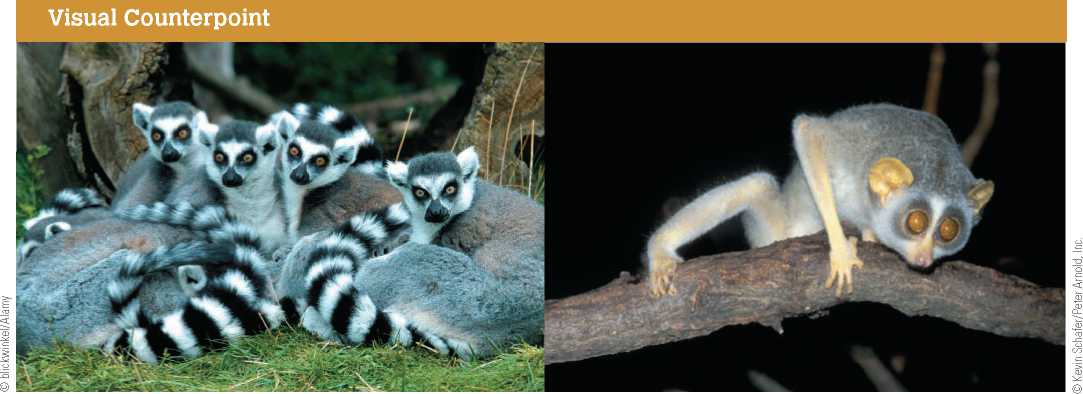
Wherever there is competition from the anthropoid primates, prosimian species, such as this loris on the right, retain the arboreal nocturnal patterns of the earliest fossil primates. Notice its large eyes, long snout, and moist split nose—all useful in its relatively solitary search for food in the trees at night. In contrast, only on the large island of Madagascar off the eastern coast of Africa, where no anthropoids existed until humans arrived, have prosimians come to occupy the diurnal ground-dwelling niche as do these ring-tailed lemurs. While all prosimians still rely on scent, marking their territory and communicating through smelly messages, daytime activity allowed the prosimians on Madagascar to become far less solitary. Also notice the difference in the size of the eyes in these two groups. Just as it would be incorrect to think of prosimians as “less evolved” than anthropoid primates because they bear a closer resemblance to the ancestral primate condition, it is also incorrect to think of lorises as less evolved compared to lemurs.
Combination of pad and nail provides the animal with an excellent prehensile (grasping) device for use when moving from branch to branch. The structural characteristics of the primate foot and hand make grasping possible; the digits are extremely flexible, the big toe is fully opposable to the other digits in all but humans and their immediate ancestors, and the thumb is opposable to the other digits to varying degrees.
The retention of the flexible vertebrate limb pattern in primates was a valuable asset to evolving humans. It was, in part, having hands capable of grasping that enabled our own ancestors to manufacture and use tools and to embark on the evolutionary pathway that led to the revolutionary ability to adapt through culture.
To sum up, what becomes apparent when humans are compared to other primates is how many of the characteristics we consider distinctly human are not in fact uniquely ours; rather, they are variants of typical primate traits. We humans look the way we do because we are primates, and the differences between us and others of this
Prehensile Having the ability to grasp.
Opposable Able to bring the thumb or big toe in contact with the tips of the other digits on the same hand or foot in order to grasp objects.
Order—especially the apes—are more differences of degree than differences of kind.




 World History
World History









